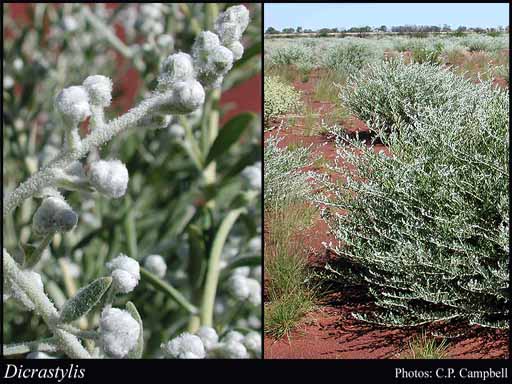- Reference
- Hooker's J.Bot.Kew Gard.Misc. 7:56 (1855)
- Name Status
- Current

Scientific Description
Common name. Sand-sages. Family Lamiaceae.
Sometimes included in Chloanthaceae, Verbenaceae.
Habit and leaf form. Perennial shrubs (or undershrubs); evergreen; without essential oils; resinous (viscid or glutinous), or not resinous. ‘Normal’ plants to switch-plants (somewhat switch-plant-like, owing to sparse leaves and broom-like habit). Leaves well developed, or much reduced. Plants unarmed. Leaves cauline. Young stems cylindrical. Stem internodes solid (woody). To 0.11–1.2(–2) m high. Leptocaul. Leaves small to medium-sized; not fasciculate; opposite, or whorled (sometimes more or less spiral); decussate; 3–5 per whorl; not decurrent on the stems; ‘herbaceous’, or leathery; petiolate, or sessile; aromatic, or without marked odour; simple; epulvinate. Leaf blades entire; flat, or rolled (recurved along margins); linear, or lanceolate, or oblong, or ovate; ovate, or oblong, or oblong to ovate, or obovate, or linear, or elliptic to oblong; 1 -nerved; pinnately veined; cross-venulate. Mature leaf blades adaxially woolly; abaxially woolly. Leaves without stipules. Leaf blade margins entire, or crenate; flat, or revolute. Leaves without a persistent basal meristem. Leaf anatomy. Hairs present; glandular hairs absent; complex hairs present. Complex hairs stellate. Stem anatomy. Secondary thickening anomalous; via concentric cambia.
Reproductive type, pollination. Fertile flowers hermaphrodite. Unisexual flowers absent. Plants hermaphrodite. Plants homostylous, or heterostylous (slightly). Entomophilous.
Inflorescence and flower features. Flowers aggregated in ‘inflorescences’. Inflorescence few-flowered to many-flowered. Flowers in cymes. The terminal inflorescence unit cymose. Inflorescences terminal, or axillary; cymose; cymes pedunculate, lax or crowded into subglobose woolly clusters (heads) arranged into corymbose, pyramidal or spicate panicles, or cymes sessile, congested to form decussate or verticillate clusters. The fruiting inflorescence not conelike. Flowers sessile, or pedicellate; bracteate; bracteolate; small to medium-sized; regular; 5 merous (rarely more or less); cyclic; tetracyclic. Free hypanthium absent. Hypogynous disk absent. Perianth with distinct calyx and corolla; 10; 2 -whorled; isomerous. Perianth members entire. Calyx present (densely tomentose outside, glabrous inside); 5 (rarely more or fewer); 1 -whorled; gamosepalous; blunt-lobed, or toothed; exceeded by the corolla to exceeding the corolla; cyathiform; regular; non-fleshy; persistent; non-accrescent. Calyx lobes linear, or ovate, or oblong, or triangular. Corolla present; 5 (mostly, rarely more or less than 5-lobed, the lobes entire or crenate at apex, mostly equal, sometimes unequal); 1 -whorled; gamopetalous; blunt-lobed; imbricate; regular, or unequal but not bilabiate (sometimes with one larger lobe); hairy abaxially; hairy adaxially (tomentose (sometimes villous)); plain; violet to blue, or white; non-accrescent. Corolla lobes elliptic to ovate, or elliptic, or oblong, or oblong to ovate. Corolla members entire. Androecium present. Androecial members definite in number. Androecium 5 (rarely more or less than 5). Androecial members adnate (epipetalous); all equal; free of one another; 1 -whorled. Androecium exclusively of fertile stamens. Stamens (4–)5. Staminal insertion in the throat of the corolla tube. Stamens scarcely to much becoming exserted; all more or less similar in shape; reduced in number relative to the adjacent perianth, or isomerous with the perianth; oppositisepalous (inserted in the corolla-tube). Filaments glabrous; filiform. Anthers dorsifixed; dehiscing via longitudinal slits; bilocular (lobes more or less oblong, free and divergent in the lower halves). Gynoecium 2 carpelled. The pistil 4 celled. Carpels reduced in number relative to the perianth. Gynoecium syncarpous; synstylovarious (styles free in upper part); superior. Ovary plurilocular; 2 locular (morphologically), or 4 locular (ostensibly, via false septa). Locules secondarily divided by ‘false septa’. Gynoecium median. Ovary summit hairy, the hairs not confined to radiating bands. Gynoecium stylate. Styles 1; forked (deeply 2-branched); attenuate from the ovary; apical; about as long as the ovary at anthesis to much longer than the ovary at anthesis; becoming exserted (or scarcely so); hairy, or hairless (sometimes in upper half). Stigmas 2; 2 - lobed. Placentation axile. Ovules 1 per locule (ostensibly, i.e. per locellus), or 2 per locule (per carpel); sessile (attached to the central axis above the middle); non-arillate; hemianatropous.
Fruit and seed features. Fruit non-fleshy; indehiscent; a nut; 4 celled; 4 locular. Dispersal unit the seed. Fruit 1–2 seeded. Seeds endospermic. Embryo straight.
Special features. Perianth (calyx) woolly outside. Inflorescence determinate. Calyx limb 5 lobed. Corolla tube exceeding the calyx, or not exceeding the calyx; straight.
Geography, cytology, number of species. Native of Australia. Endemic to Australia. Australian states and territories: Western Australia, South Australia, Northern Territory, Queensland, and New South Wales. South-West Botanical Province, Eremaean Botanical Province, and Northern Botanical Province. A genus of 26 species; 23 species in Western Australia; 18 endemic to Western Australia.
Etymology. From the Greek for "forked" and "pillar, style".